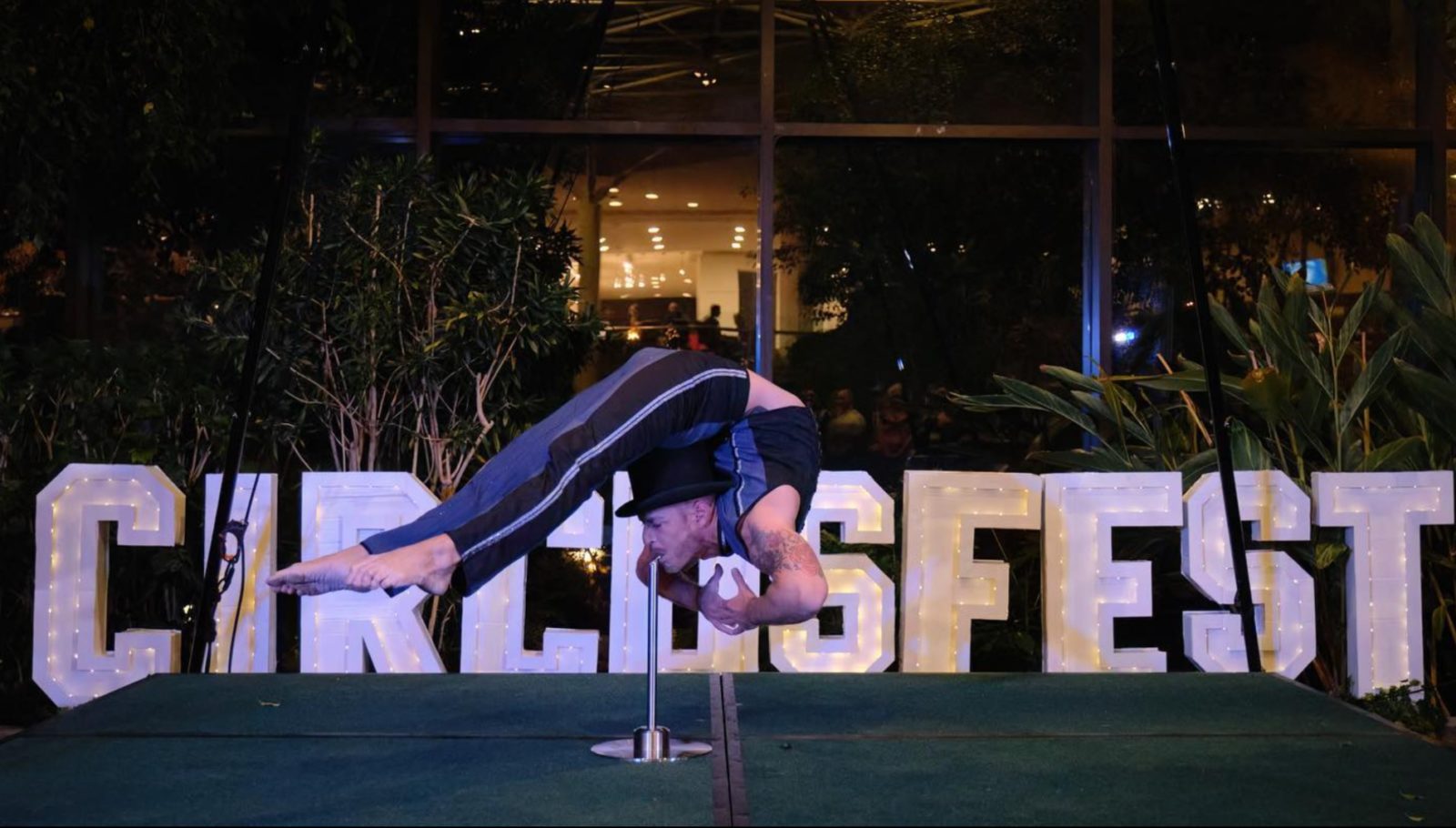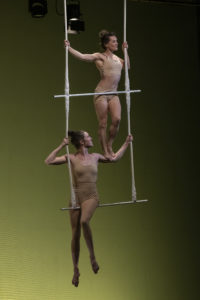The Circus Festival Where All Ends Meet

Already in its 5th edition, the St. John’s International Circus Fest provides a meeting point for far-reaching views and different forms of circus to connect in Newfoundland. Pascal Jacob reviews the art and thoughts on display at this year’s event.
Do you know about St. John’s? This unique city, the capital of the provinces of Newfoundland and Labrador, is anchored on an island at the end of the world. For five years, it has also been the sumptuous setting of the St. John’s International Circus Fest: a circus festival like no other, produced by Wonderbolt Productions, a circus company founded in 1982 which traveled by boat to enchant the most remote communities in Newfoundland. And this year, as Wonderbolt celebrates its 40th anniversary, the fifth edition of the festival makes for a beautiful tribute to all those who animate it and carry far the infinite colors of today’s circus.
There is something very logical about this joyful and yet very serious establishment of entertainers from all four corners of the planet, in the heart of a powerful place between sky and sea. Newfoundland is like a symbolic landmark–a natural confluence point between Europe and America. Circus has always been transcended by its itinerancy and taste of elsewhere, and offering a community of acrobats, clowns, and jugglers new territories to play in is nothing but the continuation of history.

One key characteristic of the St. John’s festival is offering a very dense program of meetings, workshops, and conferences, perfectly articulated in counterpart to a program of shows with very different accents. These daily comings and goings between analysis and reflection, humour, fantasy and depth—concepts associated with the same intensity to the theoretical exchanges as to the shows offered each evening—is an extremely invigorating concept.
For this fifth edition of the St. John’s International Circus Fest, the circle of speakers was very rich. Multiplying the proposals around some major structural axes, the figure of the clown emerged as a recurring theme over the five days. The close proximity of meeting spaces considerably simplified things and made participants perhaps even more available for exchanges than might be possible in another context. This theoretical, symbolic, aesthetic, philosophical, and ethical aspect of the festival is a major asset to the whole circus community—one that does not always have such favorable conditions in which to express itself and simply engage in dialogue, sharing questions and points of view. The number, quality, and diversity of the speakers have obviously contributed to making these sometimes very intense festival moments a real feast of the spirit.
The other key trait of the St. John’s Circus Fest is its multiplicity of performance venues. Three very different spaces in terms of architecture and capacity shared and housed the presentations.

Laid on a solid foundation dating back to 1789 and adorned with a beautiful façade unchanged since 1922, the LSPU Hall is a charming wooden theatre, stocked with contemporary equipment and a seating capacity of about 200. An evening on this stage is where Samuel Tétreault presented his creationGeysers, a solo piece for a balancing dancer… or perhaps the inverse. The piece explores the notion of instability, an inevitable corollary of a quest wherein controlled balance is an essential issue. Virtuoso Tétreault nevertheless endeavours to take paths beyond just offering a simple demonstration and instead stage his own interrogations of stability—to free himself from darkness and bring forth the light between introspection and performance, play and dance, strength and sensitivity.
After a short intermission, the second part of the evening offered the showRaven its first performance in North America. A creation of the company Still Hungry produced by cabaret Chamäleon of Berlin, the show is something raw and funny, held up from one end to the other by three female acrobats. We quickly guess that the framework of the show is that of their own lives.Raven is a biting parable on the desire for a child as torn apart by career choices that often make it difficult to satisfy. The theatrical expression of the twists and turns of a profession wherein motherhood sometimes complicates the existence of women more than reasonable,Raven mixes technical sequences and stage effects tinged with corrosive humour to deliver a strong and very timely message.Raven’s presence at St. John’s echoes one of the festival’s conferences, “Women in Circus,” which was devoted to the difficulty of women freeing themselves from the “canvas ceiling” of thechapiteau and applying their creative and interpretive talents without limitations. It is also part of an exciting focus on German circus: a long, rich tradition which has for several years been at the forefront of contemporary trends, nourished at the festival by a noted discussion panel of circus artists and promoters,
The LSPU stage also hosted the Foutoukours, a clown duo full of tenderness and poetry. These two performers are skillful in creating a beautiful relationship with their audience through juggling or acrobatic sequences that highlight, with great lightness, their technical mastery as artists.
The St. John’s Arts & Culture Centre is the festival’s flagship in terms of presenting shows; the main hall can accommodate nearly 1000 spectators. It was this vast stage that presentedThe Edge of the World Cabaret, a show designed by Patrick Léonard, one of the founding members of the 7 Doigts de la Main. The evening’s course is articulated through a light narrative, but the narrative is above all a pretext to offer a succession of numbers very different from each other, almost like creating an ephemeral palette of diverse intentions and tones.
It is no insult to the show’s talented cast to mention here the astonishing participation of a couple of mentalists as the strangest moment of the performance. Very worthy heirs of the mythical duo formed by Myr and Myroska in the 1950s, these two artists seem to be a little out of time, but they are of formidable efficiency. Their technique is elegantly brilliant, and they captivate the audience within a few minutes, spontaneously reviving the spirit of a music hall with a slightly old-fashioned feel. Around them, a spirited troupe of acrobats and jugglers multiplies the reasons for the audience to have fun, to soften and, above all, to applaud. This juxtaposition of numbers works a bit like a moment of freedom: it is a sequence without consequences, made up of fragments at once joyful, strong, and unusual. This cheery cabaret is the expression of a fluid and offbeat evening—like a surprise box, a little unexpected, but well-matched with the spirit of the festival.

The next evening, the same stage is occupied byMUSE, a show from the company Flip Fabrique. Acrobatic disciplines are at the service of a chain of sequences where different bodies incarnate whose diversities are a strength. The main theme ofMUSE resonates with that ofRaven, constituting the other side of a symbolic diptych. These delicate correspondences between artistic forms with sometimes different codes of representation are a beautiful challenge of coherence. This is, without a doubt, what makes these constant bridges between meaning and reflection, play and theory, so righteous and so perfect.

The circulation spaces within the Arts & Culture Centre offer interesting opportunities for exhibition installations and conferences such as “Clown Theatre,” presented by Don Rieder in front of works notably createdin situ by Karen E. Gersch. An actor, mime and dancer, Don gives himself over to a touching evocation of the great figures of theatre and play in Czechoslovakia during the 1980s. Slipping small interruptions in at unexpected places is a daring gamble, but it is also a great way to reach different audience members differently, and this quest to reach new spaces is probably another great challenge for the festival.
On the same note,A Night at The Rooms is perhaps one of the festival’s brightest moments. Introducing acrobats and their devices into spaces that are definitely not designed for them is much more than a simple challenge—it is a strong symbolic gesture. It is, the subtle implementation of another cross of cultures where it is not necessarily expected, but which proves that this complex game is one well worth developing.
Like some strange effect that resonates within the very flesh and soul of the festival, there is something essential and facetious about this event: a principle of interlocking that is as sharp as it is intelligent, and which makes acrobatic gestures as evident in a museum atrium as in a ring or on a stage. Integrate vertical dance on the level of a glass wall, say, or plant three oscillating masts several meters tall for an improbable aerial act and spectacular choreography, happening literally at eye level for many spectators. The strength of the place is in their arrangement. From a succession of staircase flights, landings, and balconies, acrobatic or juggling sequences unfold for nearly two hours—the timespan of a show that does not necessarily call itself a show by name. The result is inspiring, and symbolizes perfectly the “mosaic” feeling of the festival.
St. John’s Circus Fest cultivates the effect of dispersal, the dispersal of spaces as well as spirits, as the cleverest way to build a beautiful circus ecosystem here at the confluence of a river and an ocean. Spreading out encounters, events, and shows all over the city is not only a way to draw new lines of artistic force, but above all, it is means to affirm a strong identity.
How can we not dream now of installing a Big Top at St. John’s? It would add one more aesthetic layer to a festival that is definitely not like the others: a space nicely shared between pleasure and knowledge, and which is undoubtedly on the map of unmissable circus events.
Editor's Note: At StageLync, an international platform for the performing arts, we celebrate the diversity of our writers' backgrounds. We recognize and support their choice to use either American or British English in their articles, respecting their individual preferences and origins. This policy allows us to embrace a wide range of linguistic expressions, enriching our content and reflecting the global nature of our community.
🎧 Join us on the StageLync Podcast for inspiring stories from the world of performing arts! Tune in to hear from the creative minds who bring magic to life, both onstage and behind the scenes. 🎙️ 👉 Listen now!




